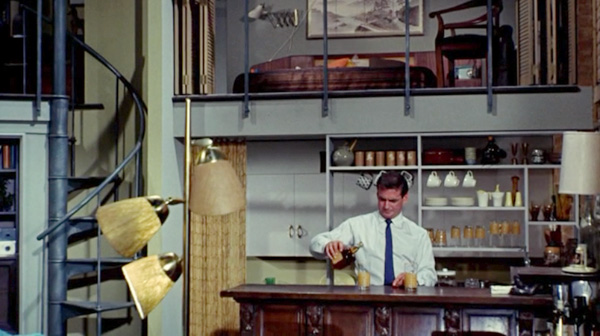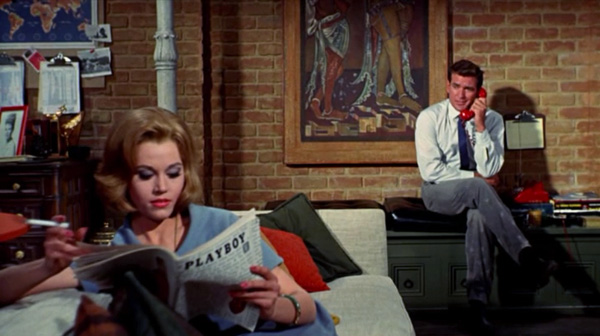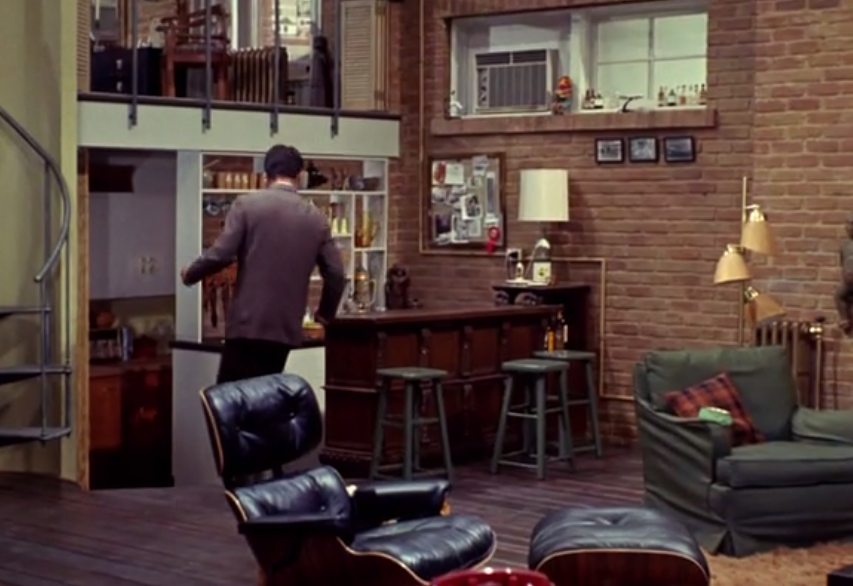
“How bold one gets when one is sure of being loved.”
~Sigmund Freud
Fortunately for mid-century modern enthusiasts, bold doesn’t have to equate with orange, molded fiberglass chairs or plaid, polyester slacks. Instead, bold can be defined as standing your ground, holding to your tastes, convictions, passions… Simply, boldness is knowing who you are and remaining fearless to express it…or blog about it.
Two Sundays ago I was down with the flu. In the theme of staying true to myself, I decided this was the perfect opportunity to find a mid-century sex comedy to watch, preferably one I hadn’t already seen. While flipping through Facebook that afternoon, a post to a favorite page of mine, “The Retro Cocktail Hour,” jumped out at me. It was Bobby Darin’s version of “Sunday in New York”, put to a video. I only hit the play button to hear Darin sing. But to my delight, the video contained clips of the 1963 movie of the same name. Who knew there was a movie? And with Rod Taylor? I was immediately all over that.
Admittedly, I haven’t seen many Jane Fonda films. I haven’t even got sweaty to Jane Fonda’s Workout video. But eight minutes into this film I found myself impressed with her acting, a skill highlighted by the perky boldness of the character she played.
Fonda portrays Eileen Tyler, an Albany newspaper writer who heads to New York City early on a Sunday morning. Her first stop is the apartment of her older brother, a swinging bachelor employed as a commercial pilot for TWA. She’s escaping the unhappiness of a break-up with her beau and looking for an answer to a question regarding the specific reason why men continue to dump her.
Her quandary? “Is a girl that’s been going around with a fellow for a reasonable length of time supposed to go to bed with him or not?” Bold, direct, and impassioned—Miss Fonda delivers this line like a boss. Impressive, considering Fonda was only twenty-six and this was her first big role. Relevant, considering her character is a twenty-two-year-old virgin.
Her playboy brother, Adam, played by Cliff Robertson, is shocked by her question and explains that men want to marry decent girls, and that the men comprising her love life must be bums. Then he delivers a bit of his own boldness by lying to her. He insists he’s not slept with anyone. Well…the “not sleeping” part is true.
Rod Taylor, whom I adore as an actor, is Mike Mitchell, a sports writer from Philadelphia who enjoys going to New York on Sundays, often in pursuit of romance. Masculine and somewhat aggressive, Mike never overwhelms Eileen but dances the man/gentleman line. His reaction to her virtue sends the storyline in an unexpected new direction, and initiates a stimulating and honest discussion about sex for “beginners.”

A strong fourth character introduced in the first scene with Adam and Eileen is Adam’s Manhattan apartment. Although many of the details of the apartment such as the doors and trim, fireplace mantel, columns, and stairway in the outside hall suggest the building is early twentieth century— possibly even Victorian— its renovated architecture and décor are indeed mid-century modern.
The bedroom, living room, and kitchen are on different levels yet remain completely open to each other. Adam is able to stand in his living room and toss his luggage up to the bedroom on the second level. A crude, industrial metal spiral staircase is the access to the bedroom and is used throughout the film brilliantly to create comedy, tension, and suspense.

A handful of modern pieces play into the space; a sleek, cone, tension-pole, lamp light and an off-white, clean-lined sofa boasts an array of earth toned pillows, to name a couple. Anchoring the entire apartment, and perhaps the movie as a whole, is arguably the most iconic mid-century modern chair ever designed—the Eames lounge chair (670) and its side kick ottoman (671).
Introduced in 1956 for the Herman Miller Furniture Company, this chair and ottoman was designed by husband and wife team, Charles and Ray Eames, after years of development. These pieces were the first exception to the couple’s rule of making “the best for the most for the least,” as this set was a high end product inspired by the traditional English Club Chair. Masculine, modern, upscale…it’s no wonder this chair received a starring role in this film.

The Eames Chair and Ottoman—a truly central character.

Sunday in New York mirrors two unlikely characters against each other: Eileen and the Eames lounge.
Features of Eileen’s polished style—bright blue eyes, perky golden locks, and slender figure—are well suited for the seven costume changes she undergoes on this one day. Designed by Orry George Kelly, her clothing is tasteful, attractive, and conservatively fashionable. The Eames lounge, comparatively, is supported by polished rosewood and elegantly dressed in supple, black leather. Charles and Ray Eames designed the lounge to appeal to affluent men. Eileen’s look has the same allure.
The storyline focuses on how three different men react to the status of Eileen’s sexuality, and her frustration with the situation. Unfortunately, the lounge and ottoman take the brunt of her agitation as she bounces off the chair’s armrest and seat. Mike’s in a state of exasperation both times he briefly sits on the ottoman. Not once in the film does anyone settle into the chair, elevated their feet on the ottoman, and relax. But that’s exactly what this furniture was designed for—someone to sink into it’s supportive goodness and fall in love.
The mid-century boldness of both characters, the girl and the chair, lay not in flashiness but in the fact they are both one-of-a-kind. An introspective Eileen states “…it’s my firm conviction I’m the only 22-year-old virgin alive.” When first unveiled to the buying public, the exclusive Eames lounge was simply a piece of furniture like nothing else.
Ultimately, Eileen finds sustaining love without first sacrificing her virginity. Does the Eames chair find the love it desires? Well, this same lounge chair (670) and ottoman (671) have been in continuous production by Herman Miller using virtually the same design since they were introduced in 1956. That’s sixty years of love between the lounge and consumers with affluence and good-taste.
If Sigmund Freud had the opportunity to analyze the Eames lounge, could he of come up with a better definition of love? I think within an hour we’d find him cradled in leather, peacefully taking a nap. And I can’t think of a better thing to do on a rainy Sunday in Vienna, or more appropriately, New York.
Sources:
Wikipedia. N.p.,n.d. Web. 16 Mar 2016.
<https://en.wikipedia.org/wiki/Eames_Lounge_Chairurces>
Wikipedia. N.p.,n.d. Web. 16 Mar 2016.
<https://en.wikipedia.org/wiki/Eames_Lounge_Chair>
Herman Miller Store. Web. 16 Mar 2016.
“The Best for the Most for the Least”. Eames Official Site. Web. 16 Mar 2016
<http://www.eamesoffice.com/the-work/the-best-for-the-most-for-the-least/>
<https://en.wikipedia.org/wiki/Eames_Lounge_Chair>
Another GREAT story! I love your work. Sorry you were sick.
Thanks so much, Kay! So glad you enjoyed it.
Great story and nice enhancements to the blog site – like the inclusion of ads.